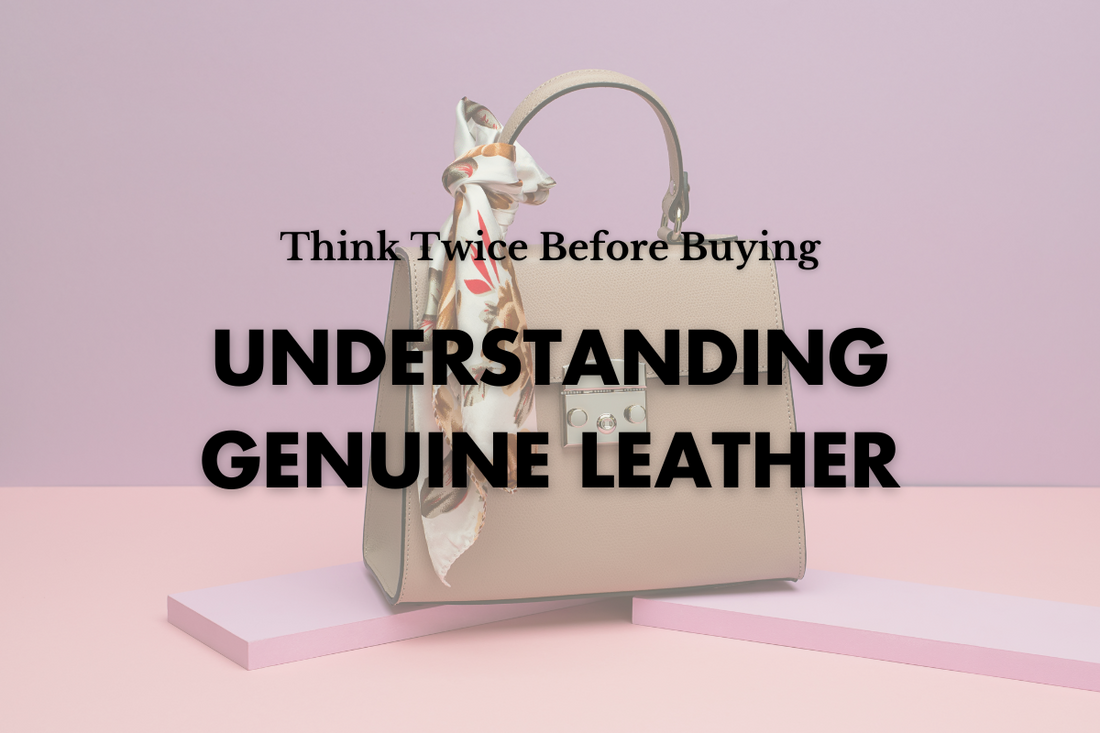
Understanding Genuine Leather: Why You Might Want to Think Twice Before Buying
Share
What is Genuine Leather?
Genuine leather is a widely recognized term in the leather industry. However, contrary to what many might believe, "genuine" does not denote high quality. Instead, it simply means the product is made from real leather, differentiating it from synthetic or faux leather. Genuine leather is typically made from the lower layers of a hide, after the top grain has been split off.
How Genuine Leather is Made
The Leather-Making Process:
-
Raw Hide Preparation:
- Hides, often byproducts of the meat industry, are cleaned and prepared by removing hair, flesh, and impurities through soaking and liming.
-
Tanning:
- The hides are tanned to stabilize their protein structure and prevent decomposition. Chrome tanning, which uses chromium salts, is the most common and cost-effective method for producing genuine leather.
-
Splitting:
- The tanned hides are split into layers. The top layer, called the grain layer, is reserved for higher-quality leathers, while the lower layers are used for genuine leather.
-
Processing and Finishing:
- Genuine leather undergoes processes like sanding, buffing, and embossing to correct imperfections. It is then dyed and finished with a protective coating to enhance durability and appearance.

An example of one of the many different types of genuine leather, with polyurethane coating over split leather, reserved for lower quality goods.
Common Practices and Uses
Practices:
- Correcting Imperfections: Genuine leather is often heavily treated to hide natural blemishes, including sanding, buffing, and embossing.
- Dyeing and Finishing: The leather is dyed for uniform color, and a topcoat is applied for protection and durability.
- Quality Control: Despite being a lower grade, genuine leather still undergoes quality checks to ensure it meets certain standards.
Uses:
- Fashion Accessories: Commonly used in belts, wallets, handbags, and shoes due to its affordability.
- Furniture: Budget-friendly furniture pieces like sofas and chairs often use genuine leather.
- Automotive Upholstery: Some car interiors feature genuine leather for seats and trims, balancing cost and durability.
Why Genuine Leather is Popular
-
Affordability:
- Genuine leather offers a cheaper alternative to high-quality leathers like full grain or aniline, making it accessible to a wider range of consumers.
-
Versatility:
- It comes in various finishes and colors, catering to different tastes and styles, making it a popular choice for many products.
-
Authenticity:
- Unlike synthetic leather, genuine leather is made from real animal hide, offering a more authentic feel and smell.
The Drawbacks of Genuine Leather
Durability:
- Less Durable: Genuine leather is not as durable as higher-quality leathers. It tends to wear out faster and can show signs of wear and tear more quickly.
- Poor Aging: Over time, genuine leather does not develop the rich patina associated with higher-quality leathers, often looking worn and tired instead.
Appearance:
- Artificial Finishes: The heavy processing required to correct imperfections can result in a more artificial look and feel, lacking the natural character of higher-quality leathers.
Comfort:
- Breathability: Genuine leather does not breathe as well as top grain or full grain leather, potentially making it less comfortable in applications like upholstery and footwear.
Environmental Impact
Tanning Process:
- Chemical Use: Chrome tanning, widely used for genuine leather, involves harmful chemicals that can be damaging to the environment if not properly managed.
- Water Pollution: The tanning process generates wastewater containing chemicals and organic matter, posing a risk to water sources.
- Waste Management: Leather production produces solid waste that needs to be properly disposed of or recycled.
Sustainability Concerns:
- Resource Intensive: Leather production is resource-intensive, consuming large amounts of water and energy.
- Animal Welfare: The sourcing of hides raises ethical concerns, as they are a byproduct of the meat industry.

When synthetic materials such as polyurethane and other plastics get laminated to natural or biodegradable materials like leather, it poses a problem of recyclability or biodegradability. Opt for high quality, full grain or top grain leathers for both it's longevity and biodegradability.
Customer Experiences with Genuine Leather
Initial Appeal:
- Cost-Effective: Genuine leather products often attract customers with their lower price points and wide availability.
Long-Term Satisfaction:
- Wear and Tear: Many customers find that genuine leather products do not hold up well over time, showing wear and tear more quickly than expected.
- Lack of Patina: Unlike higher-quality leathers, genuine leather does not develop a desirable patina, leading to disappointment as the product ages.

Familiar sight? The common issue with genuine leather products, especially in humid countries like Singapore, is the delamination of materials. Leather is porous and breathable, where as synthetic polymers used for genuine leather may not be. This clash of materials causes delamination.
Conclusion: Why You Might Want to Think Twice
While genuine leather is a popular choice due to its affordability and versatility, it comes with significant drawbacks that might make you reconsider. The lower durability, artificial appearance, and environmental concerns associated with genuine leather mean that it often does not provide the long-term value or aesthetic appeal of higher-quality leathers. Investing in top grain or full grain leather might be more cost-effective in the long run, providing a more durable, beautiful, and environmentally responsible alternative.
By understanding the true nature of genuine leather, you can make more informed choices and opt for higher-quality leather products that offer better longevity, comfort, and satisfaction.

